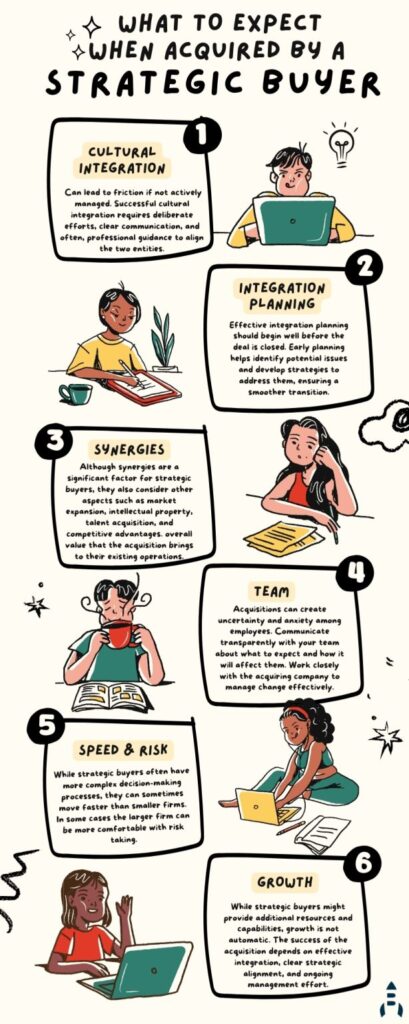One of the most fascinating moments in our work is when a founder-led business is preparing for acquisition by a larger strategic buyer. The questions start flowing fast:
- Will we report into a new structure?
- Who decides budgets?
- How long will it take to get new software approved—or even new toilet rolls? 🧻
While these questions seem minor, they reflect a deeper truth:
Even in tech, acquisitions are fundamentally mergers of people.
The good news? Most strategic buyers are good—because they know how fragile post-deal value can be. They deploy integration teams, show up face-to-face on day one, and are usually more people-savvy than founders expect.
That said, no two integrations are the same. But there are patterns—many of which are captured neatly in the infographic below. Let’s break it down.

1. Cultural Integration: Align or Clash
Cultural mismatches are one of the biggest threats to integration success.
Strategic buyers who succeed deliberately align values, communication rhythms, and expectations—often with external support. It’s not about copying each other, but connecting clearly and respectfully.
2. Integration Planning: Don’t Wait for Close
Effective integration begins before the ink dries.
Good buyers identify key systems, roles, risks, and friction points in advance. This avoids last-minute surprises and gives teams time to adapt.
3. Synergies: It’s More Than Cost Savings
Yes, cost synergy matters. But great buyers also look at market reach, IP, cross-selling opportunities, and product compatibility.
Tech due diligence here helps clarify the realistic integration wins—beyond what’s in the pitch deck.
4. Team Dynamics: Communicate Early, Often, Honestly
The team is always watching.
Acquisitions create uncertainty—so good buyers and sellers co-create messaging, involve key leaders early, and make space for questions. Transparency builds trust faster than a new org chart ever will.
5. Speed & Risk: The Big Player Might Be Faster Than You Think
Big buyers aren’t always slow.
With mature playbooks, resources, and experience, they often move faster than expected—and sometimes take more risk, not less. The key is understanding their operating rhythm early.
6. Growth: Not Guaranteed, But Possible
A strategic acquisition can unlock new channels, funding, and scale.
But growth isn’t automatic. It depends on how well the integration is executed, whether strategic alignment is real, and how well both sides manage post-deal expectations.
M&A Is Always a Merger of Cultures
From due diligence through to post-merger integration, the tech, team, and timing must all line up. But it’s the people and mindset that truly make the difference.
So if you’re a founder prepping for exit, or an investor supporting a sale:
Don’t just focus on tech. Focus on how your team will show up on Day One—and what kind of partner the buyer will be.




